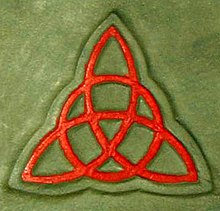Triquetra

Triquetra (IPA: [tɹaɪ'kwεtɹə]) is a word derived from the Latin tri- ("three") and quetrus ("cornered"). Its original meaning was simply "triangle" and it has been used to refer to various three-cornered shapes. Nowadays, it has come to refer exclusively to a certain more complicated shape formed of three vesicae piscis, sometimes with an added circle in or around it.
Ancient usage
Germanic paganism
The triquetra has been found on runestones in Northern Europe and on early Germanic coins. It presumably had pagan religious meaning and it bears a resemblance to the Valknut, a symbol associated with Odin.
Celtic art
The triquetra is often found in Insular art, most notably metal work and in illuminated manuscripts like the Book of Kells. While it is uncertain what the symbol may have meant to the Celts, it is often found as a design element in larger drawings of triskeles or triple spirals.
Christian use
The symbol was later used by Christians as a symbol of the Trinity (Father, Son and Holy Spirit). This appropriation was particularly easy because the triquetra conveniently incorporated three shapes that could be interpreted as Christian Ιχθυς symbols.
A common representation of the symbol is with a circle that goes through the three interconnected loops of the Triquetra. The circle emphasizes the unity of the whole combination of the three elements.
Modern use
Neopaganism
Modern Pagans use the triquetra to symbolize a variety of concepts and mythological figures.
Germanic Neopagan groups who use the triquetra to symbolize their faith generally believe it is originally of Norse and Germanic origins. Celtic Reconstructionist Pagans use the triquetra either to represent one of the various triplicities in their cosmology and theology (such as the tripartite division of the world into the realms of Land, Sea and Sky), or as a symbol of one of the specific triple Goddesses, for example, The Morrígan.
The symbol is also sometimes used by Wiccans and some New Agers to symbolize either the Wiccan triple goddess, the interconnected parts of our existence (Mind, Body, and Soul), or many other concepts that seem to fit into this idea of a unity.
Popular culture

- The triquetra is often used artistically as a design element when Celtic knotwork is used. Many who identify as Modern Celts may use the symbol to display an identification with Celtic culture, whether they live in the Celtic Nations or the diaspora.
- In recent years, the symbol has become well-known due to its use on the cover of the "Book of Shadows" used by the three sisters on the American TV show Charmed. It identifies the three sister witches working together as one.
- A triquetra is one of the four symbols on the cover of the Led Zeppelin album, Led Zeppelin IV, where it used as the personal symbol of bassist John Paul Jones.
- The triquetra has recently been adopted as the logo of the Ontario New Democratic Party in Canada.
- The band Payable on Death (P.O.D.) uses this symbol on most of their CD covers.
- The triquetra is used to represent the Trinity on The New King James Version Bibles, published by Thomas Nelson, Inc.
Geometry
Topologically, the interlaced form of the plain triquetra is a trefoil knot.
Gallery of variant forms
-
Triquetra in blue as part of an interlaced Christian Trinitarian decorative symbol.
-
Triquetra composed exactly of three overlapping Vesica piscis symbols.
-
Tightly-knotted form of triquetra.
-
An interlaced double Triquetra.
-
Triquetra interlaced with circle as Christian Trinitarian symbol (a "Trinity knot").
-
The cross of triquetras or Carolingian Cross.
-
Triquetra on one of the Funbo Runestones, located in the park of Uppsala university.







